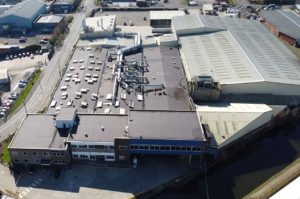Daresbury drives forward tomorrow’s world

THE 15-year-plan to cement the place of the Sci-Tech Daresbruy in Cheshire as a centre of science, research and innovation is ahead of schedule.
Particle accelerators and super computers are part of the enduring appeal of the campus which dates back to the early days of post war physics innovation in the 1950s.
An ongoing £20m programme to triple the size of the campus will reach new momentum when a contract is signed for the delivery of 56,000 sq ft of speculative office and laboratory space within the next few weeks.
John Downes, chief executive of Langtree, which has a 50% stake in the property on the campus and who is a director of the Sci-Tech Daresbury joint venture board, said the campus would grow from its current size of 500,000sq ft to 1.5m sq ft during the course of the development.
The campus– already home to more than 100 cutting-edge businesses with a total more than 1,000 staff on site – is 90% occupied and Downes has no qualms about proceeding with the speculative build, alongside public realm work which will make the site more pedestrian friendly.
There is also planning proposal for the development of a 100,000sq ft gateway infrastructure site to house independent units along with plans to include a linea park next to the access road.
“The site weathered the economic storm which started in 2008 very well,” said Downes. “I came here in 2010 but the key was getting Enterprise Zone status in 2012.”
It was around that time it was decided private money was also needed to develop the campus it became a partnership between Halton Borough Council, the North West Development Agency, and the Government-backed Science and Technologies Facilities Council (STFC) as well as Langtree.
“The plans for the campus centred on STFC and a number of companies collaborating and further their private sector interests,” said Downes. “The basis was that they would come here and collaborate with each other and there was genuine campus activity here.
“The campus having Enterprise Zone status has helped us enormously. That’s because its gives Sci-Tech Daresbury a higher profile for government funding and that the local authority can raise capital on projections of future rates income.
“There is something special about this site – it’s next to STFC and Innovation Centre, and there is the Cockroft Institute where both Manchester and Liverpool Universities collaborate. It’s the Daresbury factor, where the private and public sectors and academia collaborate.
“We got a 15-year time line when we applied for Enterprise Zone status. I believe it will take place quicker than that as the change and feel of the campus and it starts to get traction.”
Cutting edge particle accelerators and one of the UK’s most powerful super computers are part of the STFC facility.








